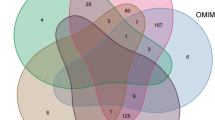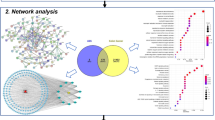Abstract
Background
Studies have shown that extracts from Lycium barbarum exerted protective effects against colorectal cancer (CRC) cells. We used the network pharmacology method to determine the effects of L. barbarum on CRC and to predict core targets, biological functions, pathways, and mechanisms of action.
Method
We obtained the active compounds and their targets in L. barbarum via use of the Traditional Chinese Medicine System Pharmacology Database (TCMSP), gathered the CRC targets from Malacards, TTD, GeneCards, and DisGeNET, and chosen the overlapped targets as the candidate targets. After protein–protein interaction (PPI) network analysis, 20 with the highest node degree were selected as the core targets, and their enrichment and pathways were analyzed. Furthermore, we employed iGEMDOCK to validate the compound-target relation.
Result
Eventually, 103 overlapped targets were chosen as the candidate targets. Targets with the top 20 highest node degree were selected as the core targets. Gene Ontology (GO) enrichment analysis indicated that the core targets were enriched in cell proliferation regulation, extracellular space, cytokine receptor binding, and so on. Kyoto Encyclopedia of Genes and Genomes (KEGG) pathway analysis proved that the core targets were significantly enriched in bladder cancer, pathways in cancer. The docking results demonstrated that beta-sitosterol, glycitein, and quercetin had good binding activity to CRC putative targets.
Conclusion
Our work successfully predicted the functioning ingredients and potential targets of L. barbarum in CRC and illustrated the potential pathways and mechanisms comprehensively. Nevertheless, these results still call for in vitro and in vivo experiments to validate.





Similar content being viewed by others
References
Siegel RL, Miller KD, Fedewa SA et al (2017) Colorectal cancer statistics, 2017. CA Cancer J Clin 67(3):177–193. https://doi.org/10.3322/caac.21395
Pardamean B, Baurley JW, Pardamean CI et al (2016) Changing colorectal cancer trends in Asians. Int J Colorectal Dis 31(8):1537–1538. https://doi.org/10.1007/s00384-016-2564-z
Howlader N, Noone AM, Krapcho M et al (2016) SEER cancer statistics review, 1975–2013, National Cancer Institute. Bethesda, MD. https://seer.cancer.gov/archive/csr/1975_2013/, based on November 2015 SEER data submission, posted to the SEER web site, April 2016
Dekker E, Tanis PJ, Vleugels J et al (2019) Colorectal cancer. Lancet 394(10207):1467–1480. https://doi.org/10.1016/S0140-6736(19)32319-0
Mao F, Xiao B, Jiang Z et al (2011) Anticancer effect of Lycium barbarum polysaccharides on colon cancer cells involves G0/G1 phase arrest. Med Oncol (Northwood, London, England) 28(1):121–126. https://doi.org/10.1007/s12032-009-9415-5
Li W, Gao M, Han T (2020) Lycium barbarum polysaccharides ameliorate intestinal barrier dysfunction and inflammation through the MLCK-MLC signaling pathway in Caco-2 cells. Food Funct 11(4):3741–3748. https://doi.org/10.1039/d0fo00030b
Cui F, Shi CL, Zhou XJ et al (2020) Lycium barbarum polysaccharide extracted from Lycium barbarum leaves ameliorates asthma in mice by reducing inflammation and modulating gut microbiota. J Med Food 23(7):699–710. https://doi.org/10.1089/jmf.2019.4544
Ceccarini MR, Vannini S, Cataldi S et al (2016) In vitro protective effects of Lycium barbarum berries cultivated in Umbria (Italy) on human hepatocellular carcinoma cells. Biomed Res Int. https://doi.org/10.1155/2016/7529521
Cassileth B (2010) Lycium (Lycium barbarum). Oncology (Williston Park, N.Y.) 24(14):1353 (PMID: 21294484)
Georgiev KD, Slavov IJ, Iliev IA (2019) Antioxidant activity and antiproliferative effects of Lycium barbarum’s (Goji berry) fractions on breast cancer cell lines. Folia Med 61(1):104–112. https://doi.org/10.2478/folmed-2018-0053
Wang W, Liu M, Wang Y et al (2018) Lycium barbarum polysaccharide promotes maturation of dendritic cell via notch signaling and strengthens dendritic cell mediated T lymphocyte cytotoxicity on colon cancer cell CT26-WT. Evid Based Complement Altern Med eCAM. https://doi.org/10.1155/2018/2305683
Hsu HJ, Huang RF, Kao TH et al (2017) Preparation of carotenoid extracts and nanoemulsions from Lycium barbarum L. and their effects on growth of HT-29 colon cancer cells. Nanotechnology 28(13):135103. https://doi.org/10.1088/1361-6528/aa5e86
Qingqing Y et al (2016) Laws of medicinal herbs application in traditional Chinese medicine treatment of advanced colorectal cancer. China J Chin Med. https://doi.org/10.16368/j.issn.1674-8999.2016.01.002
Zhang GB, Li QY, Chen QL et al (2013) Network pharmacology: a new approach for Chinese herbal medicine research. Evid Based Complement Altern Med 2013:621423. https://doi.org/10.1155/2013/621423
Yuan H, Ma Q, Cui H et al (2017) How can synergism of traditional medicines benefit from network pharmacology? Molecules. https://doi.org/10.3390/molecules22071135
Li S, Zhang B (2013) Traditional Chinese medicine network pharmacology: theory, methodology and application. Chin J Nat Med 11(2):110–120. https://doi.org/10.1016/S1875-5364(13)60037-0
Zheng J, Wu M, Wang H et al (2018) Network pharmacology to unveil the biological basis of health-strengthening herbal medicine in cancer treatment. Cancers (Basel). https://doi.org/10.3390/cancers10110461
Guo Y, Bao C, Ma D et al (2019) Network-based combinatorial CRISPR-Cas9 screens identify synergistic modules in human cells. ACS Synth Biol 8(3):482–490. https://doi.org/10.1021/acssynbio.8b00237
Ru J, Li P, Wang J et al (2014) TCMSP: a database of systems pharmacology for drug discovery from herbal medicines. J Cheminform 6:13. https://doi.org/10.1186/1758-2946-6-13
Rappaport N, Twik M, Plaschkes I et al (2017) MalaCards: an amalgamated human disease compendium with diverse clinical and genetic annotation and structured search. Nucleic Acids Res 45(D1):D877–D887. https://doi.org/10.1093/nar/gkw1012
Wang Y, Zhang S, Li F et al (2019) Therapeutic target database 2020: enriched resource for facilitating research and early development of targeted therapeutics. Nucleic Acids Res. https://doi.org/10.1093/nar/gkz981
Stelzer G, Rosen N, Plaschkes I et al (2016) The GeneCards Suite: from gene data mining to disease genome sequence analyses. Curr Protoc Bioinform 54:1301–13033
Piñero J, Bravo À, Queralt-Rosinach N et al (2017) DisGeNET: a comprehensive platform integrating information on human disease-associated genes and variants. Nucleic Acids Res 45(D1):D833–D839. https://doi.org/10.1093/nar/gkw943
Szklarczyk D, Morris JH, Cook H et al (2017) The STRING database in 2017: quality-controlled protein–protein association networks, made broadly accessible. Nucleic Acids Res 45(D1):D362–D368. https://doi.org/10.1093/nar/gkw937
Shannon P, Markiel A, Ozier O et al (2003) Cytoscape: a software environment for integrated models of biomolecular interaction networks. Genome Res 13(11):2498–2504. https://doi.org/10.1101/gr.1239303
Huang DW, Sherman BT, Lempicki RA (2009) Systematic and integrative analysis of large gene lists using DAVID bioinformatics resources. Nat Protoc 4(1):44–57. https://doi.org/10.1038/nprot.2008.211
Burley SK, Berman HM, Bhikadiya C et al (2019) RCSB Protein Data Bank: biological macromolecular structures enabling research and education in fundamental biology, biomedicine, biotechnology and energy. Nucleic Acids Res 47:D464–D474. https://doi.org/10.1093/nar/gky1004
Pettersen EF, Goddard TD, Huang CC et al (2004) UCSF Chimera–a visualization system for exploratory research and analysis. J Comput Chem 25(13):1605–1612. https://doi.org/10.1002/jcc.20084
Yang JM, Chen CC (2004) GEMDOCK: a generic evolutionary method for molecular docking. Proteins 55(2):288–304. https://doi.org/10.1002/prot.20035
Bin Sayeed MS, Ameen SS (2015) Beta-sitosterol: a promising but orphan nutraceutical to fight against cancer. Nutr Cancer 67(8):1214–1220. https://doi.org/10.1080/01635581.2015.1087042
Huang J, Xu M, Fang Y et al (2017) Association between phytosterol intake and colorectal cancer risk: a case–control study. Br J Nutr 117(6):839–850. https://doi.org/10.1017/S0007114517000617
Yuan L, Zhang F, Shen M et al (2019) Phytosterols suppress phagocytosis and inhibit inflammatory mediators via ERK pathway on LPS-triggered inflammatory responses in RAW264.7 macrophages and the correlation with their structure. Foods (Basel, Switzerland) 8(11):582. https://doi.org/10.3390/foods8110582
Lee I, Kim E, Kim D (2012) Inhibitory effect of β-sitosterol on TNBS-induced colitis in mice. Planta Med 78(9):896–898. https://doi.org/10.1055/s-0031-1298486
Dolai N, Kumar A, Islam A et al (2016) Apoptogenic effects of β-sitosterol glucoside from Castanopsis indica leaves. Nat Prod Res 30(4):482–485. https://doi.org/10.1080/14786419.2015.1023201
Sharmila R, Sindhu G (2017) Evaluate the antigenotoxicity and anticancer role of β-sitosterol by determining oxidative DNA damage and the expression of phosphorylated mitogen-activated protein kinases’, C-fos, C-jun, and endothelial growth factor receptor. Pharmacogn Mag 13(49):95–101. https://doi.org/10.4103/0973-1296.197634
Zang Y, Feng Y, Luo Y et al (2019) Glycitein induces reactive oxygen species-dependent apoptosis and G0/G1 cell cycle arrest through the MAPK/STAT3/NF-κB pathway in human gastric cancer cells. Drug Dev Res 80(5):573–584. https://doi.org/10.1002/ddr.21534
Wang Y, Kwak JH, Lee K et al (2020) Isoflavones isolated from the seeds of Millettia ferruginea induced apoptotic cell death in human ovarian cancer cells. Molecules (Basel, Switzerland) 25(1):E207. https://doi.org/10.3390/molecules25010207
Porter K, Fairlie WD, Laczka O et al (2020) Idronoxil as an anticancer agent: activity and mechanisms. Curr Cancer Drug Targets. https://doi.org/10.2174/1568009620666200102122830
Huang C, Hsu B, Wu N et al (2010) Anti-photoaging effects of soy isoflavone extract (aglycone and acetylglucoside form) from soybean cake. Int J Mol Sci 11(12):4782–4795. https://doi.org/10.3390/ijms11124782
Bielecki A, Roberts J, Mehta R et al (2011) Estrogen receptor-β mediates the inhibition of DLD-1 human colon adenocarcinoma cells by soy isoflavones. Nutr Cancer 63(1):139–150. https://doi.org/10.1080/01635581.2010.516867
Lee EJ, Kim SY, Hyun JW et al (2010) Glycitein inhibits glioma cell invasion through down-regulation of MMP-3 and MMP-9 gene expression. Chem Biol Interact 185(1):18–24. https://doi.org/10.1016/j.cbi.2010.02.037
Harwood M, Danielewska-Nikiel B, Borzelleca JF et al (2007) A critical review of the data related to the safety of quercetin and lack of evidence of in vivo toxicity, including lack of genotoxic/carcinogenic properties. Food Chem Toxicol 45(11):2179–2205. https://doi.org/10.1016/j.fct.2007.05.015
Bischoff SC (2008) Quercetin: potentials in the prevention and therapy of disease. Curr Opin Clin Nutr Metab Care 11(6):733–740. https://doi.org/10.1097/MCO.0b013e32831394b8
Hirpara KV, Aggarwal P, Mukherjee AJ et al (2009) Quercetin and its derivatives: synthesis, pharmacological uses with special emphasis on anti-tumor properties and prodrug with enhanced bio-availability. Anti-cancer Agents Med Chem 9(2):138–161. https://doi.org/10.2174/187152009787313855
Mutoh M, Takahashi M, Fukuda K et al (2000) Suppression of cyclooxygenase-2 promoter-dependent transcriptional activity in colon cancer cells by chemopreventive agents with a resorcin-type structure. Carcinogenesis 21(5):959–963. https://doi.org/10.1093/carcin/21.5.959
Srivastava NS, Srivastava RAK (2019) Curcumin and quercetin synergistically inhibit cancer cell proliferation in multiple cancer cells and modulate Wnt/β-catenin signaling and apoptotic pathways in A375 cells. Phytomed Int J Phytother Phytopharmacol 52:117–128. https://doi.org/10.1016/j.phymed.2018.09.224
Cruz-Correa M, Shoskes DA, Sanchez P et al (2006) Combination treatment with curcumin and quercetin of adenomas in familial adenomatous polyposis. Clin Gastroenterol Hepatol 4(8):1035–1038. https://doi.org/10.1016/j.cgh.2006.03.020
Chuammitri P, Srikok S, Saipinta D et al (2017) The effects of quercetin on microRNA and inflammatory gene expression in lipopolysaccharide-stimulated bovine neutrophils. Vet World 10(4):403–410. https://doi.org/10.14202/vetworld.2017.403-410
Liu Y, Tang Z, Lin Y et al (2017) Effects of quercetin on proliferation and migration of human glioblastoma U251 cells. Biomed Pharmacother Biomed Pharmacother 92:33–38. https://doi.org/10.1016/j.biopha.2017.05.044
Olson ER, Melton T, Dickinson SE et al (2010) Quercetin potentiates UVB-induced c-Fos expression: implications for its use as a chemopreventive agent. Cancer Prev Res (Philadelphia, Pa.) 3(7):876–884. https://doi.org/10.1158/1940-6207.CAPR-09-022
Ruiz PA, Braune A, Hölzlwimmer G et al (2007) Quercetin inhibits TNF-induced NF-kappaB transcription factor recruitment to proinflammatory gene promoters in murine intestinal epithelial cells. J Nutr 137(5):1208–1215. https://doi.org/10.1093/jn/137.5.1208
Richter M, Ebermann R, Marian B (1999) Quercetin-induced apoptosis in colorectal tumor cells: possible role of EGF receptor signaling. Nutr Cancer 34(1):88–99. https://doi.org/10.1207/S15327914NC340113
Qi J, Yu J, Li Y et al (2019) Alternating consumption of β-glucan and quercetin reduces mortality in mice with colorectal cancer. Food Sci Nutr 7(10):3273–3285. https://doi.org/10.1002/fsn3.1187
Granato M, Rizzello C, Gilardini Montani MS et al (2017) Quercetin induces apoptosis and autophagy in primary effusion lymphoma cells by inhibiting PI3K/AKT/mTOR and STAT3 signaling pathways. J Nutr Biochem 41:124–136. https://doi.org/10.1016/j.jnutbio.2016.12.011
Refolo MG, D'Alessandro R, Malerba N et al (2015) Anti proliferative and pro apoptotic effects of flavonoid quercetin are mediated by CB1 receptor in human colon cancer cell lines. J Cell Physiol 230(12):2973–2980. https://doi.org/10.1002/jcp.25026
Yang L, Liu Y, Wang M et al (2016) Quercetin-induced apoptosis of HT-29 colon cancer cells via inhibition of the Akt-CSN6-Myc signaling axis. Mol Med Rep 14(5):4559–4566. https://doi.org/10.3892/mmr.2016.5818
Samuel T, Fadlalla K, Mosley L et al (2012) Dual-mode interaction between quercetin and DNA-damaging drugs in cancer cells. Anticancer Res 32(1):61–71 (PMID:22213289)
Author information
Authors and Affiliations
Corresponding author
Ethics declarations
Conflict of interest
The authors declare that they have no conflict of interest.
Electronic supplementary material
Below is the link to the electronic supplementary material.
Rights and permissions
About this article
Cite this article
Lu, Y., Sun, J., Hu, M. et al. Network Pharmacology Analysis to Uncover the Potential Mechanisms of Lycium barbarum on Colorectal Cancer. Interdiscip Sci Comput Life Sci 12, 515–525 (2020). https://doi.org/10.1007/s12539-020-00397-1
Received:
Revised:
Accepted:
Published:
Issue Date:
DOI: https://doi.org/10.1007/s12539-020-00397-1




